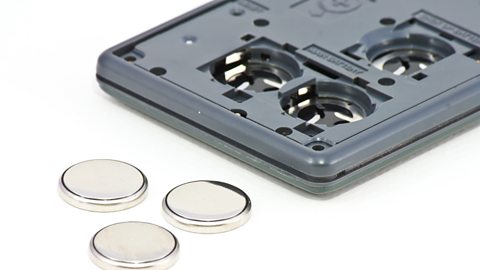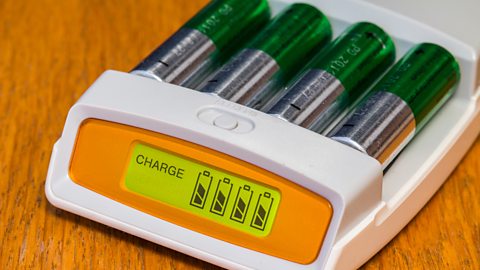Energy storage
Batteries
The two main types of batteries that are commonly used are single-use and rechargeable. The single-use batteries, sometimes referred to as primary types, are commonly alkalineHas a pH greater than 7 - an alkaline battery has an alkaline electrolyte of potassium hydroxide unlike previous batteries that used acidic electrolytes. batteries, and these are readily available in supermarkets and shops.
All batteries are available in a range of sizes and shapes - tiny batteries known as button-cell batteryA small, flat, single-cell battery that is between 5 mm and 25 mm in diameter, giving it a shape like a button. power calculators and hearing aids, while very large batteries power cars and trucks.

Common forms of batteries used in homes are AA and AAA, and both typically produce around 1.5 volts (V) per battery. A larger PP3 battery, often used for smoke alarms and medical equipment, typically produces 9 volts (V) per battery.
Once a battery runs out it has to be replaced unless it is rechargeable, in which case it is connected to a mains power source to be recharged.

Rechargeable batteries:
- are more expensive to purchase than single-use batteries
- can be recharged
- are more economical in the long term
- have a limited lifespan
Rechargeable batteries can only be recharged a number of times before they lose battery life, in the same way as smartphoneA mobile phone with a powerful processor that is capable of running applications and accessing the internet. batteries lose battery life over time.
Batteries can be recycledUsed materials that have been reprocessed to make new materials. to prevent them ending up in landfill sitesPlaces where refuse is buried underground.. Batteries contain harmful chemicals and metals that are bad for the environment if disposed of incorrectly; these elements can contaminate the ground or poison the wildlife that may eat them.
Kinetic-pumped storage systems
A kinetic-pumped storage system is a fast-acting electrical energy storage system to top up the National GridThe network that connects all of the power stations in the country to make sure that everywhere has access to electricity. power supply at peak times when more electricity is needed. A kinetic-pumped storage system works by having two reservoirA place where water is stored. and a hydroelectric damA structure built to slow down or stop the flow of a river. This creates a large lake or reservoir, which can be used for water supply, leisure or electricity generation. system.
During the night excess electricity is produced by other electrical energy stations, meaning the cost of the electricity is much lower, so a kinetic-pump plant will pump the water from a lower reservoir up to a higher reservoir, where the water remains. When there is a sudden need for more electricity (spike) during the daytime, the dam is opened and the water from the top reservoir passes through pipes, spinning turbines to quickly produce the electricity needed.